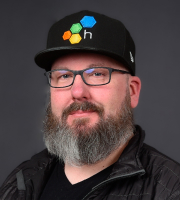Who is software for? It’s an interesting question, because there’s an obvious answer. It’s for the users, right? If your job is to write software, then it’s implied that the most important thing you should care about is the experience people have when they use your software.
I think this is a bit of an over-simplification, though. Yes, we build software for our users, but we also build it for ourselves. At some level, I believe all developers are in it for themselves. They like to see the thinking rock respond to the commands they give it. There’s a level of intellectual curiosity that grips many of us when we write software, the quiet joy of getting one over on this unfeeling collection of silicon and cobalt, bending it to our will and mastering its arcane language.
Part of this joy comes from the slow understanding that we accrete as we build systems. There’s something a bit indescribable about the feeling you get when you’ve been staring at an intractable problem for hours or days, adding more logging, more test cases, more profiles and probes, and realization begins to dawn. It’s a mixture of impish delight and sometimes head-scratching exasperation, but it’s a real feeling: the ‘aha’ moment that snaps you back in and keeps you going.
How can we scale this joy? How can we make these aha moments more accessible for other developers? I believe OpenTelemetry is a big part of the answer, and I’m excited to announce that I’ve joined the team at Honeycomb as Director of Open Source to help accelerate this journey.
Who is OpenTelemetry for?
It’s clear that OpenTelemetry is here to stay. As a project, it has nearly eclipsed Kubernetes in development velocity. Thousands of organizations are using it in production today, including Honeycomb customers like Vanguard, Equinix, and CCP Games. Honeycomb was an early adopter of OpenTelemetry, and their continued involvement and support is unquestionable. In fact, I feel comfortable making a prediction: within five years, OpenTelemetry will truly be a ‘built in’ feature of many popular frameworks, libraries, runtimes, orchestration platforms, and so forth.
It is this future that is most interesting to me. Historically, and even today, monitoring and observability are often viewed as “day two” problems, or issues to be tackled by operations teams, SREs, or platform engineers. As OpenTelemetry becomes a native experience, it risks leaving developers behind.
If we’re to truly change how we build systems, then we can’t settle for that. Developer experience must become a first-class feature of OpenTelemetry. It’s crucial for all developers, be they engineers trying to model their system, or maintainers integrating OpenTelemetry into existing frameworks and libraries.
Honeycomb’s commitment to OpenTelemetry
Honeycomb has long been a leader in not only defining what observability is, but also in how it is done. OpenTelemetry has been integral to our vision from its earliest days, and we continue to put our full support behind the project. Our dream isn’t to just make OpenTelemetry more complete, it is to make it more delightful for developers, SREs, DevOps teams, and anyone else involved in building and running software. It is not enough that OpenTelemetry is useful. It needs to be explainable, understandable, and a joy to use.
We will pursue this dream through our continued contributions to the project, and by making smart investments towards our vision of what OpenTelemetry can be. If you’re interested in this, I’d love to hear from you. Book some time with me and let’s chat!
Reducing mean time to aha
I believe that OpenTelemetry can help unlock a paradigm shift in how developers make their systems observable. It’s a flywheel that reduces the time from “huh?” to “aha!” by providing invaluable telemetry data to developers, as well as giving them an expressive language to model and talk about what their system is doing.
At Honeycomb, we’ve built the most powerful tool on the planet for developers to ask questions about what their system is doing, and to understand why things are happening. With OpenTelemetry, we’ll make it even easier for you to express what your software does. We can’t wait to help you answer all the questions you didn’t even know you needed to ask.









